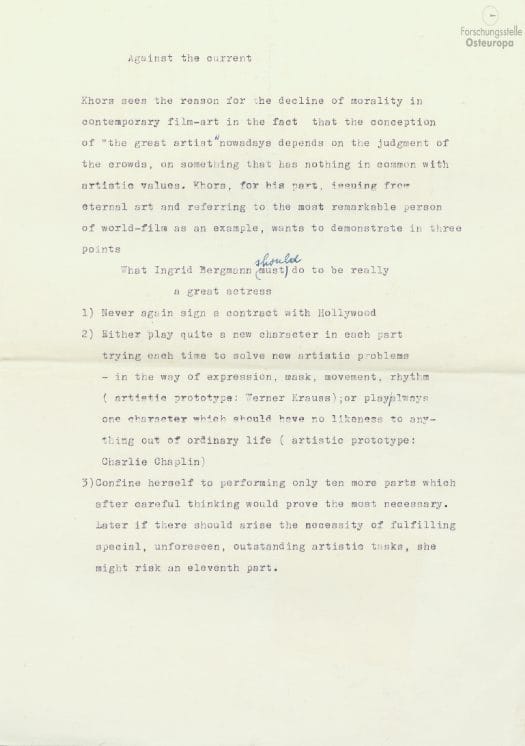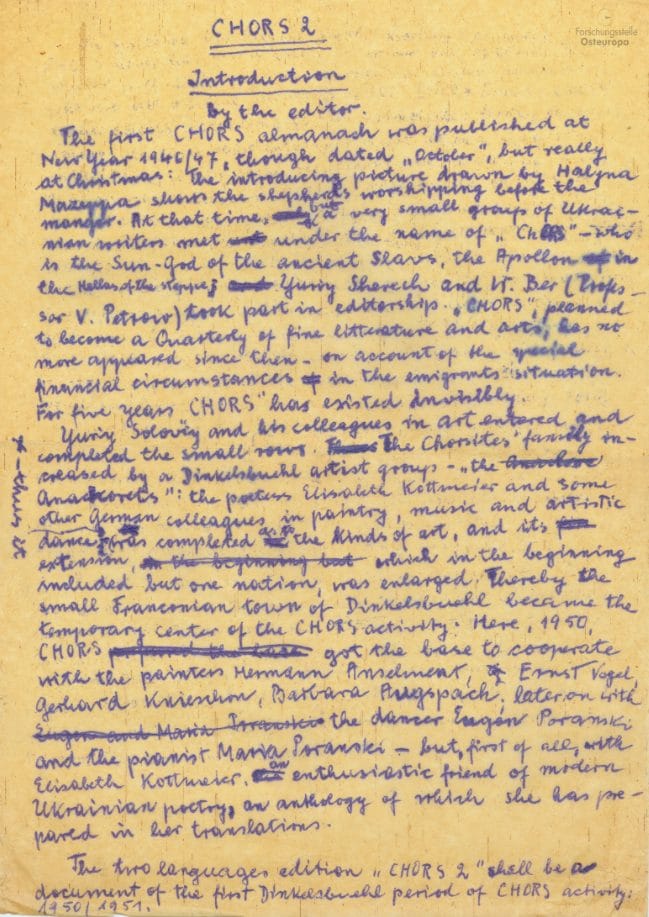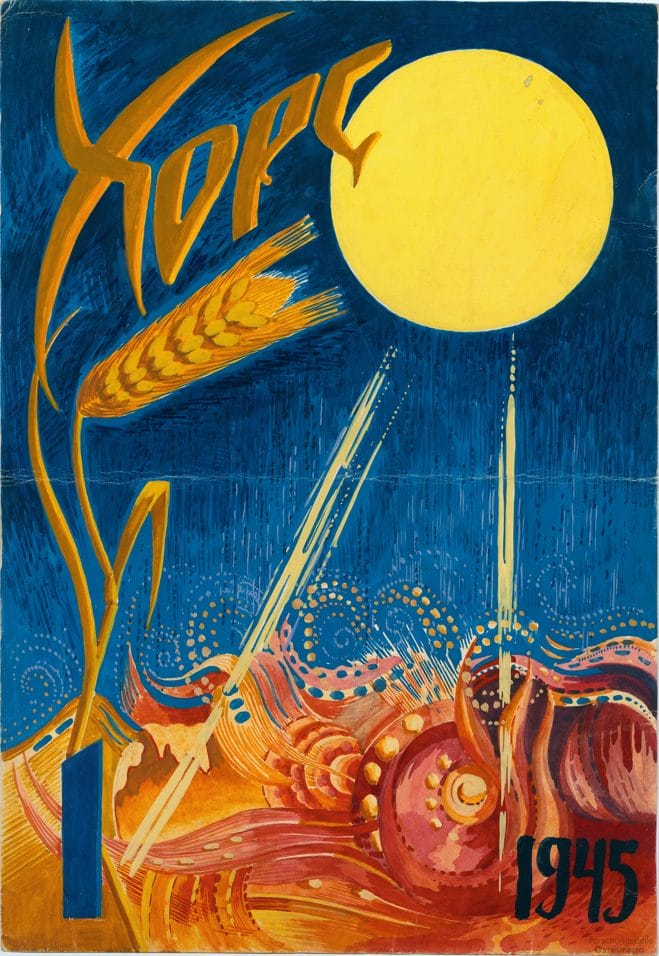Open KHORS letter
to the German film producers
Dear Gentlemen,
The art of film is in danger. The economic dictatorship of Hollywood businessmen, who have nothing in common with art, has led to standardization, the equalization of subjects and artistic means, and the loss of good taste. Even the most outstanding literary works, when they get caught up in the cogs and teeth of the Hollywood machine, flattened, castrated, represented by patented “heroes” and “heroines” like Tyron Power or Mian O’Hara, turn into tabloid productions, into mass-produced, anti-artistic “coca-cola.” But the greatest tragedy of contemporary film is the loss of individuality: the screenwriter, the director, but first and foremost – the actor. The great actors of silent film, each of whom was a cosmos of art, were great fathers with no worthy heirs in the gray, faceless, meaningless mass of today’s cinema actors.
We turn to you, honored German film industrialists, with the call to resolutely return to the sources. Once in the great times after the first war, Germany became the cradle of world film art through expressionist art. It would be a great joy for us, for all those for whom the life of art is their daily bread, to see artistic Germany once again at the forefront of the world art movement – and we call on you to make every effort to bring about this new renaissance.
Our first suggestion to you would be: to put aside the current market plans, unite joint efforts, and create at least a few artistic films that would have as their core the chef d’oeuvres of the silent era and would present in new versions a harmony of the “old” and the “new”; in their nature a bridge between what the silent film gave to the art of the actor and the director and what the sound film enriched it with.
We mean: “The Cabinet of Dr. Caligari,” “The Tired Death,” “Dr. Mabuse the Gambler,” the old “Indian Tomb,” “Nibelungen,” “Metropolis,” “Faust…”
The majority of the artists – the director Fritz Lang, the writers Thea von Harbour and Norbert Jaques, the actors Lil Dagover, Margarete Schön, Hanna Ralph, Werner Krauss, Bernhard Goetzke, Walter Janssen, Paul Richter, Rudolf Klein-Rogge, Theodor Loos, Hans Adalbert von Schlettow and others – are fortunately still alive today. They are scattered in various small ventures and only occasionally appear before the audience without being united around a leading universal artistic idea, as was the case in the times of Reinhardt, Wiene, and Murnau. Create the possibilities for the rebirth of this idea, gather and unite these artists, and give them new weapons. Let the old beautiful cadres, with the participation of Conrad Veidt, who has already died but is still alive in the film, be integrated into the technically perfected screenplay, and let a new version of “Caligari” be created: a new version, in which excerpts with the old Somnabula are edited in [sic!]. And in this collaboration between the “old” and the “new”, let the new ideas mature, let the new generation of artists appear, to whom the older generation could hand over everything better of itself, and who would become an equal successor in the great cause of cultivating unrepeatable artistic personality.
We sincerely believe, gentlemen, that this appeal of ours will not pass your hearts by and that the matter we are touching on here is actually no less on your conscience than on ours.
Yours sincerely
Group of artists
“KHORS Family”
In original German language
Offener CHORS-Brief
an die deutschen Filmproduzenten
Sehr geehrte Herren,
Die Kunst des Films steht in Gefahr. Die ökonomische Diktatur der Geschäftsleute aus Hollywood, die nicht mit Kunst gemeinsam haben, führte zur Standardisierung, zur Gleichmacherei der Sujets und Kunstmittel, zum Massenverlust des guten Geschmacks. Sogar die hervorragendsten literarischen Werke, wenn sie an die Rädchen und Zähnchen der Hollywood-Maschine geraten, verflacht, kastriert, repräsentiert durch patentierte „Helden“ und „Heldinnen“ wie Tyron Power oder Mian O’Hara, verwandeln sich in Boulevard-Produktion, in serienweise fabriziertes, antikünstlerisches „coca-cola“. Aber die schwerste Tragödie des zeitgenössischen Films ist der Verlust der Individualität: des Drehbuchautors, des Spielleiters, in erster Linie jedoch – des Schauspielers. Die grossen Schauspieler des Stummfilms, deren jeder ein Kosmos der Kunst war, sie waren grosse Väter, die in der grauen gesichtslosen, bedeutungsleeren Masse heutiger Kinoschmierenschauspieler keine würdigen Erben haben.
Wir wenden uns an Sie, geehrte deutsche Filmindustrielle, mit dem Aufruf, sich entschlossen zu den Quellen zu kehren. Einmal in den grossen Zeiten nach dem ersten Krieg wurde Deutschland durch die expressionistische Kunst zur Wiege der Weltfilmkunst. Es wäre eine grosse Freude für uns, für alle, denen das Leben der Kunst das tägliche Brot bedeutet, wieder das künstlerische Deutschland auf der Spitze der Weltkunstbewegung zu sehen, – und wir rufen Sie auf, mit allen Kräften diese neue Renaissance heraufzuführen.
Unser erster Vorschlag für Sie wäre: die laufenden Marktplätze beiseitelegend, gemeinsame Bemühungen zu vereinen und mindestens einige weniger künstlerische Filme zu schaffen, die als Kern die chef d’oeuvres der Stummzeiten hätten und in neuen Fassungen eine Harmonie des „Alten“ und des „Neuen“ vorstellen würden; in ihrer Art eine Brücke wären zwischen jenem, was der Kunst des Schauspielers und des Spielleiters der Stummfilm gab und dem, wodurch der Tonfilm sie bereicherte.
Wir meinen: „Das Kabinett des Dr. Caligari“, „Der müde Tod“, „Dr. Mabuse, der Spieler“, das alte „Indische Grabmal“, „Nibelungen“, „Metropolis“, „Faust“…
Die Mehrzahl der Künstler – der Spielleiter Fritz Lang, die Schriftsteller Thea von Harbou und Norbert Jacques, die Schauspieler Lil Dagover, Margarete Schön, Hanna Ralph, Werner Krauss, Bernhard Goetzke, Walter Janssen, Paul Richter, Rudolf Klein-Rogge, Theodor Loos, Hans Adalbert von Schlettow und andere – sind heute noch zum grösstem [sic!] Glück am Leben. Sie sind in verschiedene kleine Unternehmungen zerstreut und treten nur gelegentlich vor den Zuschauer, ohne um eine führende universale Kunstidee, wie es in den Zeiten der reinhardt, Wiene und Murnau war, vereint zu sein. Schaffen Sie doch die Möglichkeiten für die Wiedergeburt dieser Idee, sammeln und vereinen Sie diese Künstler, geben Sie ihnen neue Waffen in die Hand. Lassen Sie alte schöne Kadern [sic!] unter der Teilnahme des schon verstorbenen, aber im Film lebenden Conrad Veidt sich einfügen in das technisch vervollkommnete Drehbuch, und lassen Sie eine neue Fassung des „Caligari“ schaffen: eine neue Fassung, in der Ausschnitte mit dem alten Somnambula einmontiert einmontiert [sic!] werden. Und lassen Sie in dieser Zusammenarbeit zwischen dem „Alten“ und dem „Neuen“ die neuen Gedanken reifen, den Künstlernachwuchs auftreten, welchem die ältere Generation alles Bessere von sich übergeben könnte, und welcher ein ebenbürtiger Nachfolger in der grossen Sache der Pflege unwiederholbarer künstlerischer Persönlichkeit würde.
Wir glauben aufrichtig, geehrte Herren, dass dieser Aufruf nicht an Ihren Herzen vorbeigehen wird, und dass die Sache, die wir hier berühren, eigentlich auf Ihrem Gewissen nicht minder liegt als auf dem unseren.
Hochachtungsvoll
Künstlergruppe
“Familie CHORS”








The Ukrainian DP journal KHORS was planned as a quarterly about art and culture. It was published by a group of editors headed by writer Ihor Kostetskyi. Although the second issue was never published, the editorial notes and pre-written articles ready for publication in the planned second issue speak a lot about the potential inherent in the project. In its statute, KHORS resolutely distanced itself from communism and the Soviet Union. The reason for this position, among other things, was the Soviet ideologization of art. For Ukrainian DPs in the Western occupation zones of postwar Germany, such criticism was not only commonplace but almost expected. However, KHORS went one step further.
One of the sections that was planned to be permanent was film criticism. Here, the editors sought to publish reviews and critiques of contemporary and past films. In the second issue, two articles were planned, among others: an article about the actress Ingrid Bergman and an open letter to the German film industry. Both harshly criticized the contemporary US film industry. Hollywood was portrayed as the end of true filmmaking, and the fact that films were made for the masses was seen as a disgrace to artistic thought. Instead, the era of silent films was portrayed as a positive example of true cinema that should be returned to.